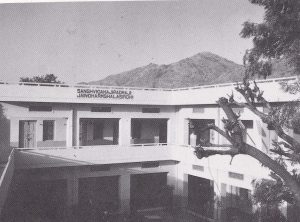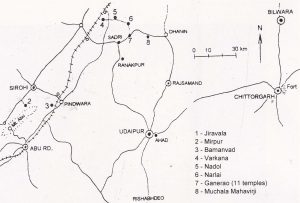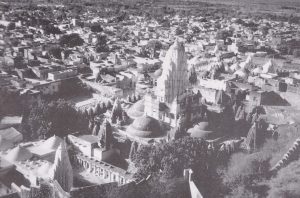Rajasthan
Sirohi
 Sirohi and Southern Aravalli Range.
Sirohi and Southern Aravalli Range.
With its two Jaina dharmashalas and a well-conducted bus station, Sirohi is a convenient stopover for travellers who are inclined towards discovering for them- selves lesser known, but in no way inferior. holy Jaina sites in the vicinity of this ancient city that was founded in about the fourth century BC under the name of Shivapuri. From 1405 onward, after the devastation of Chandravati at the south- eastern foot of Mount Abu by Muslim forces, it was the capital of Sirohi State, up to Independence in 1947 when it was incorporated into Rajasthan.
In Sirohi itself there are sixteen temples, all Shvetambara. The earliest of the thirty-four inscriptions dis- covered in these temples dates from 1167. But most of the shrines were built in
- 1-Jiravala

- 2- Mirpur
- 3- Bamanvad
- 4- Varkana 5-Nadol
- 6 Narlal
- 7-Ganerao (11 temples)
- 8-Muchala Mahavirji
Sirohi. The new dhar- mashala, located next to a Hindu temple in the main bazaar street. The other, more secluded, Jaina dharmashala is found in a big traditional building close to the temples shown in ill.
 the sixteenth/seventeenth century. The best known is the Parshvanatha temple. The partly deserted palace of the Sirohi royal family, towering above the old part of the town where most of the Jaina temples are situated, is closed to the public. To illustrate the view of Sirohi being a suitable place for undertaking short excursions, there is, to start with, seven kilometres from Sirohi Road towards Abu Road a prominent hill with a large complex of temples called Bamanvad.
the sixteenth/seventeenth century. The best known is the Parshvanatha temple. The partly deserted palace of the Sirohi royal family, towering above the old part of the town where most of the Jaina temples are situated, is closed to the public. To illustrate the view of Sirohi being a suitable place for undertaking short excursions, there is, to start with, seven kilometres from Sirohi Road towards Abu Road a prominent hill with a large complex of temples called Bamanvad.
It is sacred to Mahavira and a popular destination for Shvetambara pilgrims. The earliest inscription on this hill dates from 1292, but there are remains which are much older. An extensive re-renovation took place in 1979. Lord Mahavira’s footprints are worshipped on top of the hill.
Jiravala Parshvantha, another temple connected with Sirohi by direct bus, is thought to be one of the oldest sacred Jaina sites in Rajasthan. Located on a mountain range near Revdar, sixty-five kilometres to the south-west of Sirohi, it is a rewarding place to visit.
There are in that remote temple, installed in fifty-two small sub-shrines (devakulikas), 108 Parshvantha images, cach bearing a different name, a pecularity not found anywhere else in the country. The principal idol, also representing Parshvanatha but only eighteen centimetres in height, is believed to have been made of sand mixed with milk.
View of Sirohi from the height of the old palace. All the towers and cupolas seen in the photo belong to Jaina temples. The lofty one in the centre is the ‘four-faced’ Parshvanatha Mandir.